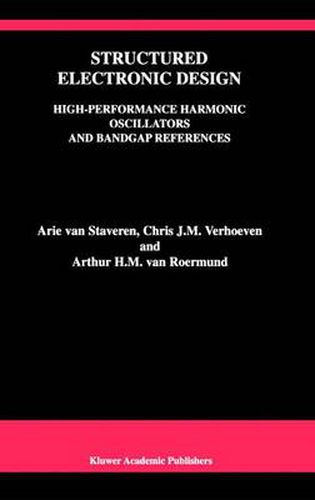Readings Newsletter
Become a Readings Member to make your shopping experience even easier.
Sign in or sign up for free!
You’re not far away from qualifying for FREE standard shipping within Australia
You’ve qualified for FREE standard shipping within Australia
The cart is loading…






This title is printed to order. This book may have been self-published. If so, we cannot guarantee the quality of the content. In the main most books will have gone through the editing process however some may not. We therefore suggest that you be aware of this before ordering this book. If in doubt check either the author or publisher’s details as we are unable to accept any returns unless they are faulty. Please contact us if you have any questions.
Analogue design still has, unfortunately, a flavour of art. Art can be beautiful. However, art in itself is difficult to teach to students and difficult to transfer from experienced analogue designers to new trainee designers in companies. This text aims to systemize analogue design. The use of orthogonalization of the design of the fundamental quality aspects (noise, distortion, and bandwidth) and hierarchy in the subsequent design steps, enables designers to achieve high-performance designs, in a relatively short time. As a result of the systematic design procedure, the effect of design decisions on the circuit performance is made clear. Additionally, the use of resources for reaching a specified performance is tracked. This text describes the structured electronic design of high-performance harmonic oscillators and bandgap references. The structured design of harmonic oscillators includes the maximization of the carrier-to-noise ratio by means of tapping, i.e. an impedance adaption method for noise matching. The bandgap reference, a popular implementation of a voltage reference, is studied via the unusual concept of the linear combination of base-emitter voltages. The presented method leads to the design of high-performance references in CMOS and Bipolar technology. Using this concept, on a high level of abstraction the quality with respect to, for instance, noise and power-supply rejection can be identified. In this book, it is shown with several design examples that this method provides an excellent starting point for the design of high-performance bandgap references. Auxiliary to the harmonic-oscillator and bandgap reference design are the negative- feedback amplifiers. The systematic design of the dynamic behavior is emphasized. By means of the identification of the dominant poles, it is possible to give an upper limit of the attainable bandwidth, even before the real frequency compensation is accomplished. This volume should be a valuable book for researchers and designers, as well as students in the field of analog design. It helps both the experienced and trainee designer to come to grips with the design of analogue circuits. The presented method is illustrated by several well-described design examples.
$9.00 standard shipping within Australia
FREE standard shipping within Australia for orders over $100.00
Express & International shipping calculated at checkout
This title is printed to order. This book may have been self-published. If so, we cannot guarantee the quality of the content. In the main most books will have gone through the editing process however some may not. We therefore suggest that you be aware of this before ordering this book. If in doubt check either the author or publisher’s details as we are unable to accept any returns unless they are faulty. Please contact us if you have any questions.
Analogue design still has, unfortunately, a flavour of art. Art can be beautiful. However, art in itself is difficult to teach to students and difficult to transfer from experienced analogue designers to new trainee designers in companies. This text aims to systemize analogue design. The use of orthogonalization of the design of the fundamental quality aspects (noise, distortion, and bandwidth) and hierarchy in the subsequent design steps, enables designers to achieve high-performance designs, in a relatively short time. As a result of the systematic design procedure, the effect of design decisions on the circuit performance is made clear. Additionally, the use of resources for reaching a specified performance is tracked. This text describes the structured electronic design of high-performance harmonic oscillators and bandgap references. The structured design of harmonic oscillators includes the maximization of the carrier-to-noise ratio by means of tapping, i.e. an impedance adaption method for noise matching. The bandgap reference, a popular implementation of a voltage reference, is studied via the unusual concept of the linear combination of base-emitter voltages. The presented method leads to the design of high-performance references in CMOS and Bipolar technology. Using this concept, on a high level of abstraction the quality with respect to, for instance, noise and power-supply rejection can be identified. In this book, it is shown with several design examples that this method provides an excellent starting point for the design of high-performance bandgap references. Auxiliary to the harmonic-oscillator and bandgap reference design are the negative- feedback amplifiers. The systematic design of the dynamic behavior is emphasized. By means of the identification of the dominant poles, it is possible to give an upper limit of the attainable bandwidth, even before the real frequency compensation is accomplished. This volume should be a valuable book for researchers and designers, as well as students in the field of analog design. It helps both the experienced and trainee designer to come to grips with the design of analogue circuits. The presented method is illustrated by several well-described design examples.